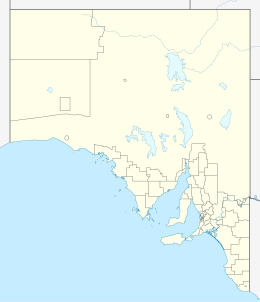Taylor Island
 Location of Taylor Island | |
| Etymology | William Taylor[1] |
|---|---|
| Geography | |
| Location | Spencer Gulf |
| Coordinates | 34°52′41″S 136°00′24″E / 34.877966°S 136.006687°E[1] |
| Area | 2.4 km2 (0.93 sq mi)[1] |
| Highest elevation | 84 m (276 ft)[1] |
| Administration | |
Taylor Island, also known as Taylor's Island, is the largest in a group of seven islands located between the Eyre Peninsula mainland and Thistle Island in the mouth of Spencer Gulf, South Australia. It was named by British explorer Matthew Flinders in 1802, after the loss of William Taylor, a midshipman and master's mate to John Thistle (after whom Thistle Island is named).[2] The remaining islands in the group are also named after lost members of Flinders' expedition: Little Island, Lewis Island, Smith Island, Hopkins Island and Grindal Island.[3] Taylor's Island has been used principally for the grazing of sheep while its surrounding waters are well regarded fishing grounds.
History
[edit]
In 1876, a sporting party described Taylor Island as being "covered with rabbits, mutton birds, and Cape Barren geese."[4]
In 1910, a trawling expedition from Largs Bay to Venus Bay on the west coast of Eyre Peninsula was abandoned after the steamer Argyle was met with high seas in the Investigator Strait. At one stage there was 7 feet of water in the well, and the ship's hand pump couldn't improve the situation. Water came within 3 inches of the furnaces, and the engineers and the firemen were working in waist-deep water. By the vessel's continual rolling motion, coal was also washed out of the bunkers and into the bilges. The coal had to be fished out of the water by hand to feed the furnaces. As the coal had about 5 feet of water over it, the work was tedious and difficult. The crews worked with buckets and hand-pumps and gradually reduced the quantity of water in the vessel. Owing to the continuous strain, all on board became exhausted. After the ordeal, the ship anchored at Taylor's Island for five days, while the crew made necessary repairs.[5]
In 1935, grazier Clarence Henry Lines was accused of stealing twenty sheep from fellow grazier R. L. C. Sinclair and five from P. S. Sinclair. The allegedly 'stolen' sheep were found grazing on Taylor Island. Lines denied having stolen the sheep and pleaded 'not guilty' in court.[6][7][8][9]
In 1940, the growth of feed for the grazing of sheep made Taylor Island 'a sight to be seen'.[10]
In 1947, Mr. Norm Johnson caught an unusually large snook off Taylor Island. It was 3 ft 3 inches in length, 10 inches in girth and weighed over 7 lbs.[11]
In March 1950, first-time big game fisherman Mr. A. Dean of Mildura hooked four great white sharks near Taylor Island. He only succeeded in landing one, which measured 11 ft. 5 inches. Its girth was 6 ft and it weighed 860 lb. Another escaped after a 30-minute struggle and was estimated to be 14 ft long.[12]
As of 1996, Taylor Island was under perpetual lease, and was still used for minor grazing.[13]
Navigation aids
[edit]A navigation aid consisting of a 9-metre-high (30 ft) tower with a single flashing light was installed in 1982. The light, which is 76 m (249 ft) above sea level, assists vessel underway at night along the east coast of the Jussieu Peninsula, particularly those vessels that approaching from the south via the Thorny Passage or the east coast of Thistle Island.[14][15]
Flora and Fauna
[edit]Plants recorded on Taylor Island include: Dryland Tea-tree (Melaleuca lanceolata), Coastal White Mallee (Eucalyptus diversifolia), Nitre bush, Pointed twinleaf, Native juniper, Kangaroo thorn, Dysentery bush, Old man's beard, Yorrell, Native lilac, Weeping pittosporum and Cockie's tongue. Western grey kangaroos were introduced to the island, but Brush-tailed possums are native there. Birds include Brown falcon, Grey fantail, Golden whistler and Richard's pipit. Rosenberg's goanna lives on the island.[13]
See also
[edit]References
[edit]- ^ a b c d "Search results for "Taylor Island" with the following datasets selected – "Suburbs and Localities", "NPW and Conservation Properties" and "Gazetteer"". Location SA Map Viewer. South Australian Government. Retrieved 24 October 2019.
- ^ Aarons, Frederick "A tardy tribute. Flinders' statue." Sydney Morning Herald, New South Wales (1925-10-06). Retrieved 2014-01-28.
- ^ Property Location Browser V2 Government of South Australia. Accessed 2014-01-20.
- ^ "A Sporting Excursion to the Neptune Islands" South Australian Chronicle & Weekly Mail, South Australia (1876-12-02). Retrieved 2014-01-24.
- ^ "A trawling expedition. Bailing for dear life. All hands exhausted." The Advertiser, South Australia (1910-06-14). Retrieved 2014-01-28.
- ^ "Defence opens its case - Hearing of charges against grazier - STRONG DENIAL", News, South Australia (1935-12-10). Retrieved 2014-01-28.
- ^ "Criminal sittings." The Advertiser, South Australia (1935-12-07). Retrieved 2014-01-28.
- ^ "Grazier remanded - Sheep stealing allegation - May be more charges", Port Lincoln Times, South Australia (1935-10-11). Retrieved 2014-01-28.
- ^ "Sheep shown to jurors - Prosecutor helps display them - THEFT CHARGES" News, South Australia (1935-12-05). Retrieved 2014-01-28.
- ^ "Season on the islands. Abundance of good sheep feed" Port Lincoln Times, South Australia (1940-08-08). Retrieved 2014-01-28.
- ^ "Large snook caught near Taylor's Island" Port Lincoln Times, South Australia (1947-05-22). Retrieved 2014-01-28.
- ^ "Newcomer to shark fishing - HOOKS FOUR ON FIRST TRIP" Port Lincoln Times, South Australia (1950-03-16). Retrieved 2014-01-28.
- ^ a b Robinson, Tony; Canty, Peter; Mooney, Trish; Rudduck, Penny (1996). South Australia's Offshore Islands (PDF). South Australia: Resource Management Branch, Department of Environment and Natural Resources, South Australia. ISBN 0 644 35011 3.
- ^ "Listed by State (i.e. lighthouses & navigation aids)". Australian Lighthouses. Archived from the original on 26 January 2014. Retrieved 2 April 2014.
- ^ Royal Australian Navy Hydrographic Service (1983). Port Lincoln and approaches (chart no. Aus 134).

